Soy sauce is a pantry staple in many kitchens around the world, lending a savory, umami punch to food. But soy sauce, as delightful as it is, can become a nightmare when it gets on your clothes. Its dark hue, and fermented components, mean it is infamous for leaving stubborn stains.
| Material | Stain Removal Method |
|---|---|
| Blot excess, pre-soak in warm water with detergent and vinegar, sponge with rubbing alcohol, and launder | |
| Blot excess, pre-soak in warm water with detergent and vinegar, sponge with rubbing alcohol, and launder | |
| Blot excess, apply mild soap foam, and dry with a clean cloth. Use cornmeal for oil stains | |
| Soy sauce can be used as a stain, but it doesn’t protect the wood. For removal, use dish soap and water | |
| Blot excess, apply carpet stain remover, and flush with water and detergent | |
| Wipe with warm sudsy water and rinse well | |
| Wash with hot soapy water and dry to prevent tarnish | |
| Blot excess, use washing soda or detergent with water, and rinse thoroughly |
Soy Sauce Stains: What You Need to Know
Why Are Soy Sauce Stains So Stubborn?
Soy sauce stains aren’t just a minor hassle, they can be downright difficult to remove. To see why, let’s consider what soy sauce consists of.
Composition: Soy sauce is a combination of soybeans, wheat, water, and salt. Fermentation is a key part of its creation, resulting in a similarly dark liquid with strong flavors. These dark pigments, called melanoidins, are an undesired by-product of fermentation that is responsible for soy sauce stains’ become so dark and resistant.
Oxidation: As soon as soy sauce gets on fabric, its enzymes and sugars begin to oxidize. This oxidization process essentially embeds the stain further into the fabric, making removal more difficult over time.
Soy Sauce Is Viscous and Has An Aqueous Base: Another potential reason soy sauce can work as an alternative dye is that it is viscous, with an aqueous base, and when the soy sauce and textile fibers are mixed, they still hold on to some of the soy sauce to create a rich and dark color. Over time, this bond gets stronger, making the stain even more difficult to clean.
To put it a different way, the distinctive ingredients of soy sauce — its dark pigments, salt and proteins — make it a decidedly troublesome stain. But don’t fret; even the most stubborn soy sauce stains can be removed with the proper techniques.
What You Need to Know to Remove Soy Sauce Stains
Fabric Type Matters
What type of fabric you’re dealing with is one of the biggest factors in how easy (or hard) it is to get soy sauce stains out. Here’s how various fabrics respond to stains:
Fabric Type How It Responds to Soy Sauce Stains Cotton Absorbs stains easily because porous Should be dealt with quickly to be effective. Silk Very delicate and can be damaged by harsh cleaning agents. Stain removal ought to be done gently. Wool Absorbs stains but not as unforgivingly as cotton. Requires gentle cleaning agents. Polyester Less absorbent, so stains remain on the surface longer and are easier to clean.
Prompt Action is Key
The sooner you take action, the easier it will be to remove the stain. When soy sauce sits on fabric it has more time to oxidize and cling to fibres. The stain might not set too deeply if you act quickly.
How to Remove Soy Sauce Stains: The Best Method
Now that you know what makes soy sauce stains so stubborn, let’s take a look at the best cleaning methods to get rid of them. It doesn’t matter if it’s a fresh spill or dried stain; these methods will help you get your clothing back to normal.
Blot and Rinse Immediately
When soy sauce spills on your clothes, the first thing you should do is move quickly. Here’s what to do:
Soak Up the Stain: Take a clean paper towel or cloth, and gently blot the excess soy sauce. Do not rub because this will only make the stain spread.
Step 1: Rinse with Cold Water: Run the stained area under cold water. Rather than embedding the stain further, allow the water to run through the back of the fabric to push the stain out.
That step is critical for new stains and can dramatically improve your odds of getting rid of the stain completely.
Using Stain Removers
If blotting and rinsing do not result in the stain being fully removed, it is time to go in with a stain remover. Commercial products (such as Shout) and DIY solutions help. Here’s an easy do-it-yourself treatment:
Make your solution: Mix 50:50 hydrogen peroxide and dish soap. The hydrogen peroxide frees the stain while the dish soap cuts grease.
- Apply to the Stain: Using a cloth or sponge, dab the mixture onto the stain and let it sit for 5–10 minutes.
- Repeat and Assess: Rinse the spot with cold water and see if the stain has lightened. Repeat as necessary.
- Method 5: Pre-Treating With Bleach (For Bleach-Safe Fabrics)
A bleach-safe option for an uncolored fabric is bleach, which is highly effective at removing soy sauce stains. Here’s how to use it:
- Dilute the Bleach: Add a small amount of bleach to a basin of water according to the product’s directions.
- Soak the Fabric: Dip the stained area into the solution and allow to soak for 5–10 minutes.
- Rinse and Wash: Rinse well under cold water, then wash the garment normally.
Warning: Do not use if clothing is colored or delicate as this may cause fading
Washing and Drying
After you have treated the stain, it’s time to wash the clothing. For maximum effectiveness, follow these tips:
Use the Hottest Setting That’s Safe: Look at the care label on your clothing and wash on the hottest setting that is safe for the fabric.
Inspect Before Drying: Before placing the item in the dryer, check the stained area. The intense heat from the dryer can set any lingering stain, making it nearly impossible to get out.
Preventing Soy Sauce Stains
Always prevention before cure. Read More: This is how you can remove soy sauce spills and stains:
Use a Tablecloth or Apron: Protect yourself from soy sauce stains.
Watch How You Pour: Soy sauce bottles are awkward and can / do splash; pour slow.
Have the Stain Removal Supplies Ready: In the event of an accidental spill, keep a small stain remover pen or wipes handy — but be sure to check whether the fabric can be treated.
The End: How to Get Soy Sauce Out of Clothes
So, is soy sauce stainy on clothes? Yes, but it can be tricky to get it out. Whether fresh or dried, soy sauce stains can be effectively addressed if you act quickly and use the right cleaning methods. Keep in mind the type of fabric and use the step-by-step methods in this guide. With some work, your clothes will be like new!
Common Questions About Soy Sauce Stains
Is soy sauce a difficult stain to remove?
No, soy sauce stains are not permanent with proper treatment. But if you don’t fight them, they can become enshrined deep in the fabric and more resistant to removal.
How do I get old soy sauce stains out?
For old stains, you can pre-treat with a mixture of dish soap and hydrogen peroxide, then wash the garment on the hottest setting that is safe for the fabric. For stubborn stains you may have to repeat the process.
Does soy sauce come out without washing?
In some cases blotting and rinsing with cold water can lift fresh stains without the need for a wash. However, washing is advised when you want to completely remove any stain.
More Tips for Stain Removal
White vinegar: A solution of white vinegar and water can help lift soy sauce stains from delicate fabrics.
Sprinkling Baking Soda: Mix baking soda with water and create a paste and lightly scrub the stain for that extra power.
You may also read (homemade upholstery cleaner)





